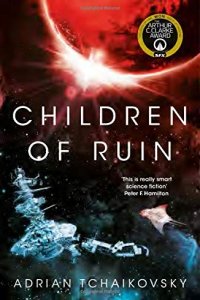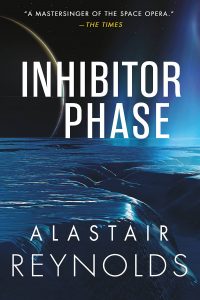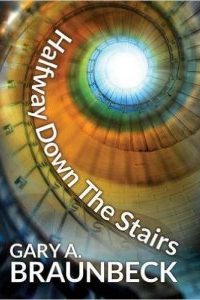Paul Di Filippo Reviews Children of Ruin by Adrian Tchaikovsky
 Children of Ruin, Adrian Tchaikovsky (Orbit 978-0316452533, $15.99, 608pp, trade paperback) May 2019.
Children of Ruin, Adrian Tchaikovsky (Orbit 978-0316452533, $15.99, 608pp, trade paperback) May 2019.
Adrian Tchaikovsky’s opener in this series, Children of Time, snapped up the Clarke Award for its year of publication, and it’s easy to see why. The book combines Stapledonian vistas with intimate human dramas, along with top-notch conceptualizations of an alien civilization. Toss in an Armageddon-extinction scenario, a generation starship, and a half-bonkers AI-posthuman godling, and you’ve got a jampacked whizbang of a tale. Of course, balancing all these high-energy elements takes talent, and Tchaikovsky proves up to the challenge.
I’ll summarize this maiden voyage briefly, to bring us up to speed for the sequel, and of course there’ll be spoilers for the first book.
We start in orbit around a distant star, reached only by the slower-than-light ships that take decades to cross the gulf between suns. In an era when human life back on Earth seems in danger of being wiped out, a somewhat desperate expedition has terraformed a planet. But not as a home for humans. The next step they intend is to sow the world with simians and an “uplift virus” that will frog march the hominids through a swift evolution and result in a new sentient species to be humanity’s partners. All of this is the brainchild of the ego-driven borderline megalomaniac Dr. Avrana Kern. But due to sabotage that results in the destruction of everyone except Kern, who escapes in a small “Sentry pod,” no monkeys land, although the virus is indeed dispersed into the ecosystem. What happens afterwards is that the virus finds a biological home in native spiders and ants, and sets off a Darwinian competition between the two species, as their intelligence levels bootstrap to full sentience. At the outset of her failure, realizing she can do nothing more, Kern goes into suspended animation until such time as her subjects reach full civilizational maturity, as will be shown by their ability to contact her in response to looped broadcasts from the Sentry.
Back on Earth, everything goes kerflooey as foreseen. Centuries later, a portion of humanity pulls itself out of the rubble and launches the generation ship Gilgamesh, where most of the 500,000 human passengers reside in suspended animation. Our viewpoint character here, among a host of keenly limned crew, is one Holsten Mason, a “classicist” and historian. The ship follows the old half-understood starmaps to Kern’s World. Kern does not take kindly to their appearance and scares them off with weaponry. But after a fruitless detour, the craft returns, intent on conquering the spider’s domain for themselves. A brief war ensues, but in the end, the two species join hands. “After all the years, the wars, the tragedies and the loss, the spiders and the monkeys are returning to the stars to seek their inheritance.”
The narrative unfolds leisurely, yet with plenty of moments of suspense, on dual tracks (shipboard and planetside). We watch the devolution of the Gilgamesh environment and society and the evolution of the spiders until the destinies converge. Tchaikovsky deploys a bold omniscience and a godlike remove from events, along with a crystalline prose. Resonating with such past cousins as John Brunner’s The Crucible of Time, Neal Stephenson’s Seveneves, Jack Williamson’s Terraforming Earth, and even the antique “Professor Jameson” stories of Neil R. Jones, the book offers plenty of thrills and intellectual stimulations, and a message of hope.
With the sequel, Tchaikovsky has ramped up his game while simultaneously circling back to recapitulate some of the pleasures of the first book. What do I mean by that? It comes down once again to a dual-track narrative.
The first part the reader encounters is the reiteration with changes. We are focused on the terraforming ship Aegean, which has gone out simultaneously with Kern’s original mission. Kern’s storyline being thousands of years advanced at the end of Children of Time, this means we are in backstory land. The Aegean, with a tiny crew of thirteen, has been sent to terraform an Earthlike world at the star Tess 834. But when they arrive, they find life of a very strange sort already present, on a planet soon denominated “Nod.” So while exploring Nod, they also turn their attention elsewhere in the system. An autistically brilliant scientist named Disra Senkovi decides to heat up the iceball world he names Damascus, and seed it, when ready, with his breed of uplifted octopuses. He just barely manages to give his tentacled godchildren a good start when actions by the alien life form on Nod sends the whole terraforming mission into a death spiral. (Think along the lines of the Borg, the Blob, and Ridley Scott’s Alien.) Then thousands of years pass so as to bring us into the shared realtime of the first book.
The joint Human-Spider mission to the stars has arrived at Tess 834. Our main characters here are Helena Holsten Lain; spiders named Portia and Fabian; Kern herself, existing nowadays only in uploaded form on a wetware platform of interconnected ants; and a man named Meshner whose brain has been modified so as to aid Kern. The visitors stumble into the perpetual war between the advanced octopuses and the Nodans. The strangers look to be destroyed as collateral damage. Unless Helena can learn to speak octopus, Kern can unriddle the nature of the Nodans, and new paradigms of sentience and cooperation can be cobbled together on the fly.
Once again, Tchaikovsky performs all the wonders of the first book, while at the same time making some quantum jumps in his sequel. The portrait of Senkovi, expressing his adoration (and fear) of his creations, as he lives to the advanced age of one-hundred-and-eighty-nine, “the last human in the cosmos,” is touching. The depiction of the octopus culture and their unique weltanschauung is innovative and fascinating, as is the lesser-glimpsed mindset of the Nodans. The exhibition of cosmological scales provides a sense-of-wonder boost. New to this volume is the First Contact riff, as Helena and Portia, captives of the “octopus space navy,” strive to communicate. (And any book that legitimately provides an excuse to say “octopus space navy” is aces with me.) Kern’s evolution from megalomaniac to guardian/mentor is well done. And the underlying message of persisting through misunderstandings, fear, and hatred until harmony and new balances are reached is not just preached, but embodied in thrills both corporeal and intellectual. Tchaikovsky’s good sense of pacing and his ability to make arcane scenes and concepts vividly transparent all contribute to a winning tale.
With the guiding spirit of Poul Anderson hovering over his shoulder, and the buttressing work of peers like Vernor Vinge and Paul McAuley standing to either side, Tchaikovsky has made that rare transition from master of fantasy to master of SF—almost as if he had sampled some uplift virus himself.
 While you are here, please take a moment to support Locus with a one-time or recurring donation. We rely on reader donations to keep the magazine and site going, and would like to keep the site paywall free, but WE NEED YOUR FINANCIAL SUPPORT to continue quality coverage of the science fiction and fantasy field.
While you are here, please take a moment to support Locus with a one-time or recurring donation. We rely on reader donations to keep the magazine and site going, and would like to keep the site paywall free, but WE NEED YOUR FINANCIAL SUPPORT to continue quality coverage of the science fiction and fantasy field.








